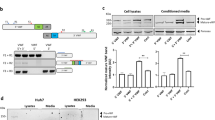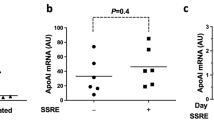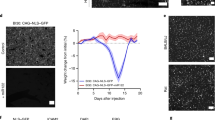Abstract
The involvement of the vascular endothelium in a large number of diseases supports the importance of vascular-specific gene delivery for their treatment. The hereditary hemorrhagic telangiectasia type 1 is an example of a vascular inherited disease (OMIM 187300). This is an autosomal dominant vascular disorder originated by mutations in the endoglin gene and associated with frequent epistaxis, telangiectases, gastrointestinal bleedings, and arteriovenous malformations in brain, lung and liver. Here, we address for the first time the possibility of using in vivo gene transfer to target endoglin expression to the vasculature. The promoter of the endothelial gene, ICAM-2, was used to generate transgenic animals which demonstrated endothelial expression of endoglin. Next, the promoters of the human endothelial genes, endoglin and ICAM-2, were inserted upstream of the human endoglin cDNA, and the resulting constructs were systemically or locally delivered, demonstrating endoglin expression in the vessel walls of liver, lung and skin. These gene transfer experiments represent an initial step in the treatment of the hereditary hemorrhagic telangiectasia type 1 by gene therapy, and suggest that endoglin and ICAM-2 promoters can be used to deliver other genes to the endothelium specifically.
This is a preview of subscription content, access via your institution
Access options
Subscribe to this journal
Receive 12 print issues and online access
$259.00 per year
only $21.58 per issue
Buy this article
- Purchase on Springer Link
- Instant access to full article PDF
Prices may be subject to local taxes which are calculated during checkout






Similar content being viewed by others

References
Cines DB et al. Endothelial cells in physiology and in the pathophysiology of vascular disorders Blood 1998 91: 3527–3561
Vallance PJ, Webb DJ . Vascular Endothelium in Human Physiology and Pathophysiology. Endothelial Cell Research Series Volume 7 Harwood Academic Publishers: Amsterdam 2000
Guttmacher AE, Marchuk DA, White RI . Hereditary hemorrhagic telangiectasia New Engl J Med 1995 333: 918–924
Shovlin CL, Letarte M . Hereditary haemorrhagic telangiectasia and pulmonary arteriovenous malformations: issues in clinical management and review of pathogenic mechanisms Thorax 1999 54: 714–729
Marchuk DA . Genetic abnormalities in hereditary hemorrhagic telangiectasia Curr Opin Hematol 1998 5: 332–338
Letarte M . CD105. In: Shaw S (ed.). Protein Reviews On The Webhttp://www.ncbi.nlm.nih.gov/prow/cd/cd105htm 1998
Gougos A, Letarte M . Identification of a human endothelial cell antigen with monoclonal antibody 44G4 produced against a pre-B leukemic cell line J Immunol 1988 141: 1925–1933
Cheifetz S et al. Endoglin is a component of the TGF-β receptor system in human endothelial cells J Biol Chem 1992 267: 19027–19030
Barbara NP, Wrana JL, Letarte M . Endoglin is an accessory protein that interacts with the signaling receptor complex of multiple members of the transforming growth factor-β superfamily J Biol Chem 1999 274: 584–594
Yamashita H et al. Endoglin forms a heteromeric complex with the signaling receptors for transforming growth factor-β J Biol Chem 1994 269: 1995–2001
Letamendía A et al. Role of endoglin in cellular responses to transforming growth factor-β. A comparative study with betaglycan J Biol Chem 1998 273: 33011–33019
Lastres P et al. Endoglin modulates cellular responses to TGF-β1 J Cell Biol 1996 133: 1109–1121
Li C et al. CD105 antagonizes the inhibitory signaling of transforming growth factor beta1 on human vascular endothelial cells FASEB J 2000 14: 55–64
Pece N et al. Mutant endoglin in hereditary hemorrhagic telangiectasia type 1 is transiently expressed intracellularly and is not a dominant negative J Clin Invest 1997 100: 2568–2579
Shovlin C et al. Characterization of endoglin and identification of novel mutations in hereditary haemorrhagic telangiectasia Am J Hum Genet 1997 61: 68–79
Gallione CJ et al. Mutation and expression analysis of the endoglin gene in hereditary hemorrhagic telangiectasia reveals null alleles Hum Mutat 1998 11: 286–294
Bourdeau A, Dumont DJ, Letarte M . A murine model of hereditary hemorrhagic telangiectasia J Clin Invest 1999 104: 1343–1351
Arthur HM et al. Endoglin, an ancillary TGFbeta receptor, is required for extraembryonic angiogenesis and plays a key role in heart development Dev Biol 2000 217: 42–53
Cowan P et al. Comparison of transgene expression driven by the endothelial-specific human ICAM-2, PECAM-1 and endoglin promoters. Sixteenth Annual Meeting of the Transplantation Society of Australia and New Zealand Canberra, Australia 1998 (Abstr. 29)
Rius C et al. Cloning of the promoter region of human endoglin, the target gene for hereditary haemorrhagic telangiectasia type I Blood 1998 92: 4677–4690
Graulich W et al. Cell type specificity of the human endoglin promoter Gene 1999 227: 55–62
Liu F, Song Y, Liu D . Hydrodynamics-based transfection in animals by systemic administration of plasmid DNA Gene Therapy 1999 6: 1258–1266
Cuevas P et al. Correction of hypertension by normalization of endothelial levels of fibroblast growth factor and nitric oxide synthase in spontaneously hypertensive rats Proc Natl Acad Sci USA 1996 93: 11996–12001
Yonemitsu Y et al. Characterization of in vivo gene transfer into the arterial wall mediated by the Sendai virus (hemagglutinating virus of Japan) liposomes: an effective tool for the in vivo study of arterial diseases Lab Invest 1996 75: 313–323
Ylä-Herttuala S, Martin JF . Cardiovascular gene therapy Lancet 2000 355: 213–221
Friedmann T . The Development of Human Gene Therapy. Monograph 36 Cold Spring Harbor Laboratory Press: Cold Spring Harbor, New York 1999
Li S, Huang L . Nonviral gene therapy: promises and challenges Gene Therapy 2000 7: 31–34
Trono D . Lentiviral vectors: turning a deadly foe into a therapeutic agent Gene Therapy 2000 7: 20–23
Wyman T et al. Promoter-activated expression of nerve growth factor for treatment of neurodegenerative diseases Gene Therapy 1999 6: 1648–1660
Shovlin CL . Supermodels and disease: insights from the HHT mice J Clin Invest 1999 104: 1335–1336
Li DY et al. Defective angiogenesis in mice lacking endoglin Science 1999 284: 1534–1537
Raab U et al. Endoglin is expressed in the chicken vasculature and is involved in angiogenesis FEBS Lett 1999 459: 249–254
Marazuela M et al. Expression of vascular adhesion molecules on human endothelia in autoimmune disorders Clin Exp Immunol 1995 102: 328–334
van de Kerkhof PC et al. Expression of endoglin in the transition between psoriatic uninvolved and involved skin Acta Derm Venereol 1998 78: 19–21
Kumar P, Wang JM, Bernabeu C . CD105 and angiogenesis J Pathol 1996 178: 363–366
Thorpe PE, Burrows FJ . Antibody-directed targeting of the vasculature of solid tumors Breast Cancer Res Treat 1995 36: 237–251
Bodey B, Bodey B Jr, Siegel SE, Kaiser HE . Immunocytochemical detection of endoglin is indicative of angiogenesis in malignant melanoma Anticancer Res 1998 18: 3621–3628
Miller DW et al. Elevated expression of endoglin, a component of the TGF-beta-receptor complex, correlates with proliferation of tumor endothelial cells Int J Cancer 1999 81: 568–572
Li C et al. Plasma levels of soluble CD105 correlate with metastasis in patients with breast cancer Int J Cancer 2000 89: 122–126
Tabata M, Kondo M, Haruta Y, Seon BK . Antiangiogenic radioimmunotherapy of human solid tumors in SCID mice using (125)I-labeled anti-endoglin monoclonal antibodies Int J Cancer 1999 82: 737–742
Folkman J, Hahnefeldt P, Hlatky L . The logic of anti-angiogenic gene therapy. In: Friedmann T (ed.) The Development of Human Gene Therapy Monograph 36. Cold Spring Harbor Laboratory Press: Cold Spring Harbor, New York 1999 pp 527–543
Cowan PJ et al. The human ICAM-2 promoter is endothelial cell-specific in vitro and in vivo and contains critical Sp1 and GATA binding sites J Biol Chem 1998 273: 11737–11744
Bellón T et al. Identification and expression of two forms of the human TGF-β binding protein endoglin with distinct cytoplasmic regions Eur J Immunol 1993 23: 2340–2345
Zhang G et al. Expression of naked plasmid DNA injected into the afferent and efferent vessels of rodent and dog livers Hum Gene Ther 1997 8: 1763–1772
López-Novoa JM . Intrasplenic infusion. A simple way for intraportal infusion in the rat Experientia 1981 37: 536–537
Letarte M et al. CD105 Workshop panel report. In: Kishimoto T et al (ed) Leucocyte Typing VI Garland Publishing Inc: New York 1997 pp 703–708
Pichuantes S et al. Mapping epitopes to distinct regions of the extracellular domain of endoglin using bacterially expressed recombinant fragments Tissue Antigens 1997 50: 265–276
Acknowledgements
We thank Drs Fátima Bosch and Anna Pujol for help with the generation of transgenic mice; Drs Luisa Botella and Angel Corbí for helpful discussions; Manuel Moreno and Carmen Langa for excellent technical assistance; and Victoria Muñoz and Mónica Fontela for photography. This work has been supported by postdoctoral fellowships from Comunidad Autónoma de Madrid to BV and MR, and by grants from Comisión Interministerial de Ciencia y Tecnología (SAF2000–0132 and SAF1998–0095), and Comunidad Autónoma de Madrid (CAM).
Author information
Authors and Affiliations
Rights and permissions
About this article
Cite this article
Velasco, B., Ramírez, J., Relloso, M. et al. Vascular gene transfer driven by endoglin and ICAM-2 endothelial-specific promoters. Gene Ther 8, 897–904 (2001). https://doi.org/10.1038/sj.gt.3301468
Received:
Accepted:
Published:
Issue Date:
DOI: https://doi.org/10.1038/sj.gt.3301468
Keywords
This article is cited by
-
Physiological and tissue-specific vectors for treatment of inherited diseases
Gene Therapy (2011)
-
Construction of a novel expression cassette for increasing transgene expression in vivo in endothelial cells of large blood vessels
Gene Therapy (2011)
-
Shear stress-induced transcriptional regulation via hybrid promoters as a potential tool for promoting angiogenesis
Angiogenesis (2009)
-
Modification of kidney barrier function by the urokinase receptor
Nature Medicine (2008)
-
Endoglin
AfCS-Nature Molecule Pages (2005)


